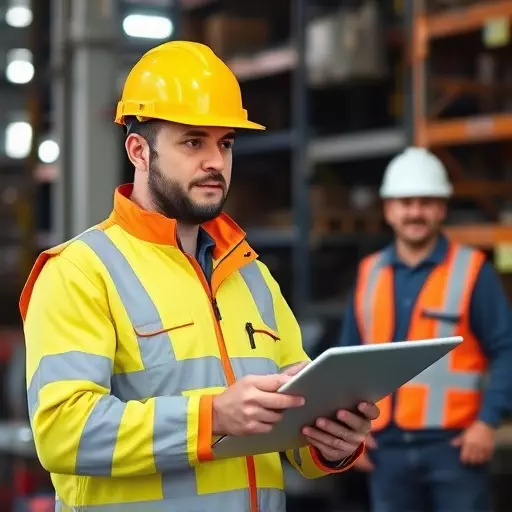Safety Leadership Programs empower organizations through specialized, industry-tailored training. These programs focus on hazard assessment techniques and safety protocol implementation, fostering a culture of proactive safety consciousness. By developing curricula aligned with unique workplace hazards, leaders equip their teams to identify and mitigate risks effectively, enhancing preparedness and adherence to safety standards. Specialized safety training, leveraging hazard assessment methods in curriculum design, has proven successful in reducing incidents and improving safety management across various sectors.
- Understanding Safety Leadership Programs: A Comprehensive Guide
- The Role of Specialized Safety Training by Industry
- Hazard Assessment Techniques for Effective Risk Management
- Curriculum Development in Safety Training: Creating Engaging Content
- Implementing and Measuring the Success of Safety Leadership Initiatives
- Case Studies: Real-World Applications of Specialized Safety Training
Understanding Safety Leadership Programs: A Comprehensive Guide

Safety Leadership Programs are designed to equip and empower individuals within organizations to take charge of their safety initiatives. These programs go beyond traditional safety training by industry-specific needs, offering a comprehensive approach that includes hazard assessment techniques and specialized safety training tailored to unique workplace environments. By focusing on leadership development, these programs foster a culture where safety is not just a responsibility but an active, collaborative effort.
The curriculum development aspect plays a pivotal role in the success of Safety Leadership Programs. A well-structured curriculum ensures that participants gain practical knowledge and skills in identifying and mitigating risks, implementing safety protocols, and fostering a safety-conscious environment. Through interactive sessions, case studies, and hands-on exercises, these programs enable leaders to effectively communicate safety goals, motivate their teams, and respond promptly to emerging hazards.
The Role of Specialized Safety Training by Industry

The effectiveness of safety leadership programs significantly hinges on the inclusion of specialized safety training tailored to specific industries. Each industry faces unique challenges and hazards, necessitating customized hazard assessment techniques and safety protocols. Specialized safety training by industry ensures that employees are equipped with relevant knowledge and skills to identify and mitigate risks peculiar to their sector. This targeted approach goes beyond generic safety seminars; it involves immersive sessions, practical demonstrations, and interactive exercises designed to address the nuances of particular industrial environments.
Industry-specific safety training curriculum development is a dynamic process that reflects evolving workplace hazards and best practices. By incorporating case studies, real-world scenarios, and hands-on training, organizations can foster a culture of proactive safety consciousness. Such programs not only enhance employee preparedness but also encourage continuous learning and adaptation to new safety standards, ensuring a safer work environment for all.
Hazard Assessment Techniques for Effective Risk Management

In the realm of safety leadership programs, hazard assessment techniques are indispensable tools for effective risk management. Specialized safety training by industry plays a pivotal role in equipping professionals with the knowledge and skills to conduct thorough assessments. By employing advanced methods, organizations can identify potential hazards, evaluate their likelihood and impact, and implement tailored strategies to mitigate risks. This proactive approach ensures that safety measures are not one-size-fits-all but instead aligned with the unique challenges of each industry.
Curriculum development in safety training focuses on integrating these hazard assessment techniques into comprehensive programs. Participants learn to analyze work environments, processes, and equipment to pinpoint hazards, considering both physical and chemical agents. They also gain proficiency in evaluating risks through probabilistic and frequency-based methods, enabling them to prioritize actions based on potential consequences. This specialized training empowers leaders to foster a culture of safety by empowering their teams with the skills to navigate complex risk landscapes.
Curriculum Development in Safety Training: Creating Engaging Content

Effective safety leadership programs rely heavily on well-designed curricula that cater to specific industry needs. Specialized safety training by industry ensures relevant and up-to-date content, aligning with unique workplace hazards. For instance, a construction site’s safety curriculum would differ from that of a healthcare facility, focusing on distinct risks like heavy machinery versus biological hazards. This tailored approach enhances engagement and comprehension among participants.
Curriculum development in safety training involves incorporating interactive elements, case studies, and hands-on exercises alongside traditional lectures. By employing hazard assessment techniques, trainers can create practical scenarios that challenge learners to identify potential risks and propose solutions. This dynamic approach not only strengthens knowledge but also fosters critical thinking and problem-solving skills crucial for real-world safety management.
Implementing and Measuring the Success of Safety Leadership Initiatives

Implementing and measuring the success of safety leadership initiatives is paramount to ensuring a culture of continuous improvement and risk mitigation. Organizations should look beyond traditional training methods by incorporating specialized safety training tailored to specific industrial sectors. This involves leveraging advanced hazard assessment techniques to identify potential risks and develop targeted, evidence-based safety training curricula.
The effectiveness of these initiatives can be gauged through comprehensive metrics that track participant engagement, knowledge retention, and behavioral changes post-training. By regularly assessing these factors, organizations can fine-tune their programs, ensuring they remain effective in the face of evolving industry standards and workplace challenges.
Case Studies: Real-World Applications of Specialized Safety Training

In today’s competitive business landscape, specialized safety training by industry is more crucial than ever. Case studies from various sectors illustrate the real-world applications of hazard assessment techniques integrated into tailored safety training programs. For instance, manufacturing plants have implemented comprehensive curricula focusing on identifying and mitigating chemical hazards, leading to significant reductions in workplace incidents. Similarly, construction sites have adopted advanced training modules emphasizing fall protection and heavy machinery safety, resulting in improved worker safety and adherence to regulatory standards.
These success stories highlight the importance of industry-specific safety training, which goes beyond generic guidelines. By leveraging hazard assessment techniques, organizations can develop targeted curricula that address unique risks inherent to their operations. Such customized training not only enhances employee preparedness but also fosters a culture of proactive safety management, ultimately contributing to a safer and more productive work environment.
